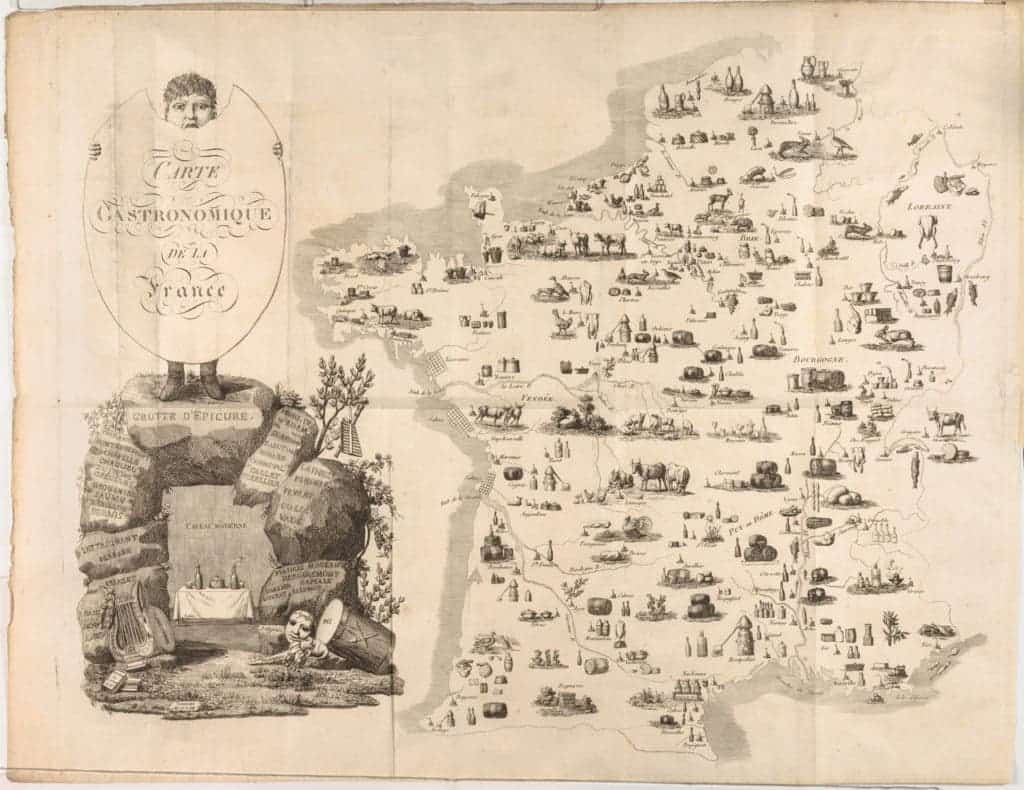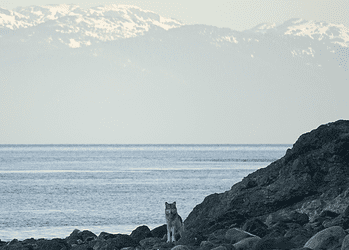In 1809, Jean François Tourcaty did something both strange and remarkable: he mapped a country through its food. Not its borders. Not its rivers. Not its cities. But its sausages, its wines, its cheeses. Meet the Gastronomical Map of France.
The original Michelin Guide
This Gastronomical Map of France was drawn for a curious little book called Cours Gastronomique. The book wasn’t meant to guide armies or travelers. It was designed for diners. On it, cows graze across Normandy, vines snake through Bordeaux, fish swim lazily near Marseille. A tiny cartouche at the edge of the page celebrates a forgotten men’s club—the Caveau Moderne—where members sang, ate, and debated beneath a ceiling of smoke and laughter.
The book’s author, Charles Louis Cadet de Gassicourt, was the illegitimate son of Louis XV. He was also a chemist, apothecary, and lawyer. He was appoitned the pharmacist to Napoleon. And like many Enlightenment thinkers, he saw no contradiction between science and the finer things in life. In fact, he insisted they belonged together. The Cours Gastronomique reads like a manifesto: gastronomy, it argues, must be informed by chemistry and physiology. Taste wasn’t just a luxury—it was a field of study.
Cadet’s book is long forgotten. But Tourcaty’s map survived. And it remains astonishing.

With beautiful drawings, the map illustrates the major cuisine products from France and highlights their origin. It shows France as a mosaic of edible ecosystems. A place where every region has a signature, not in ink or law, but in what it grows, ferments, and cures. There’s brie from Brie. Cognac from Cognac. Roquefort, veined with the mold of a specific cave, from Roquefort-sur-Soulzon. The map wasn’t just accurate—it was persuasive. It argued that a nation’s identity could be read through its terroir.
Something old, something new
Today, some of its symbols have turned quaint. Few peopole fish in the Seine anymore. Hunting in Versailles is a memory wrapped in velvet. Geneva and Brussels, for reasons presumably more cultural than cartographic, appear inside France’s borders. But so much else has endured. Bordeaux still yields its velvety reds. The southeast remains perfumed with wild herbs. The north still brews.
What makes this map extraordinary is what it leaves out: roads, rulers, wars. The things we usually think define a country. Instead, it gives us flavors. The subtext is clear: this is what binds us. The foods we eat and the things we enjoy are what make a population.
Published a decade after the Revolution, it captured a France attempting to rebuild not just its political identity, but its cultural one—plate by plate, region by region.
The map was published by the Cornell library. Its accompanying page reads:
This striking map is found at the outset of the “Cours Gastronomique” by Charles Louis Cadet de Gassicourt. It is “the first example” of a carte gastronomique, “a map that summarizes a country not by its cities, mountains, or rivers but by its products.” Ferguson 2004, 46. Although this map locates the regional sources of production (reflecting chapter xxviii of the book), it is less a geography lesson than a testament to the depth and variety of French food and wine.

Food was a central part of cultural events in that day, and few philosophical or scientific discussions were held in the absence of a rich meal. In fact, food wasn’t just a physical need, but a source of great enjoyment, knowledge, and cultural richness.
So if you’re in France and you don’t know what local food to enjoy first or if you want to know more about the delicious traditions of the country, the Gastronomical Map of France can definitely help you.








